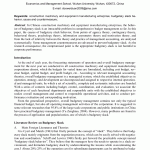As you know by now, the income statement breaks down all of your company’s revenues and expenses. You need your income statement first because it gives you the necessary information to generate other financial statements. The preparation of financial statements involves the process of aggregating accounting information into a standardized set of financials. The preparation of financial statements includes the following steps (the exact order may vary by company). The last step in the accounting cycle is preparing financial statements—they’ll tell you where your money is and how it got there.
Maintaining a healthy cash balance – aka, enough but not too much – is mission-critical. For example, if the company revalues an asset and it’s worth less, it’s the company’s loss. However, how to create progress invoicing in quickbooks online for nonprofits the loss is only realized when the company sells that asset. The net income from the income statement will be used in the Statement of Equity. Explore GnuCash’s features, safety, and comparisons with Bench Accounting, QuickBooks and other alternatives. Your concise guide to understanding GnuCash’s role in financial software.
Don’t add any other types of income here, such as income from rent or interest — that’s not revenue. Use the formula above to help calculate your retained earnings balance at the end of each period. Conduct an ending physical inventory count, or use an alternative method to estimate the ending inventory balance. Use this information to derive the cost of goods sold, and record the amount in the accounting records. Accrue an expense for any wages earned but not yet paid as of the end of the reporting period. Cash flow gives you insights into your business’s sources and uses of cash.
Step 3: Accrue Unpaid Wages
Again, your balance sheet lists all of your assets, liabilities, and equity. Your total assets must what is cash coverage ratio equal your total liabilities and equity on your balance sheet. One way of explaining the balance sheet is that it includes everything that doesn’t go on the income statement. The balance sheet lists all the assets and liabilities of the business. For example, assets include cash, accounts receivable, property, equipment, office supplies and prepaid rent. Liabilities include accounts payable, notes payable, any long-term debt the business has and taxes payable.
The statement of cash flows shows the cash inflows and cash outflows from operating, investing, and financing activities. Operating activities generally include the cash effects of transactions and other events that enter into the determination of net income. We will examine the statement of cash flows in more detail later but for now understand it is a required financial statement and is prepared last. The statement of cash flows uses information from all previous financial statements. The balance sheet, lists the company’s assets, liabilities, and equity (including dollar amounts) as of a specific moment in time. That specific moment is the close of business on the date of the balance sheet.
Step 3: Prepare the Balance Sheet
Some examples of liabilities include accounts payable, accrued expenses, and long-term loan debt. Investors, lenders, and vendors might be interested in checking out your business’s cash flow statement. That way, they can see whether or not your company is a good investment. There is more technical information about how to prepare financial statements in the next section of my accounting course. As you can see all four general-purpose financial statements are prepared and presented here. Paul can use these statements internally to gauge the performance of his store for the year or he can issue them to lenders or investors to help raise funds to expand the store.
- Accruals make sure that the financial statements you’re preparing now take those future payments and expenses into account.
- This requires a careful reconciliation of at least the major balance sheet accounts, to ensure that they only contain valid balances.
- Together they represent the profitability and strength of a company.
- The net income from the income statement will be used in the Statement of Equity.
- In the first step of the accounting cycle, you’ll gather records of your business transactions—receipts, invoices, bank statements, things like that—for the current accounting period.
Cash flow from operating activities is the sum of cash inflow and outflow from activities like collection from debtors, payment to creditors, and taxes paid. I got a university degree to learn how financial statements work and how those numbers come together to give you a comprehensive financial picture. After a stint in equity research, he switched to writing for B2B brands full-time. Arjun has since written for investment firms, consultants, and SaaS brands in the Accounting and Finance space.
How to Adjust Inventory Entries
A few examples of assets include company vehicles and inventory. Current assets are items of value that can convert into cash within one year (e.g., checking account). Noncurrent assets are items of value that take more than one year to convert into cash. Here is an example of Paul’s Guitar Shop, Inc.’s financial statements based on his adjusted trial balance in our previous example.
Step 1: Verify Receipt of Supplier Invoices
Without them, you wouldn’t be able to do things like plan expenses, secure loans, or sell your business. Calculate the closing balance in stockholders’ equity and input this figure into the balance sheet. Other comprehensive income refers to gains and losses that don’t appear on the income statement because the company hasn’t realized them yet.
Try our payroll software in a free, no-obligation 30-day trial. Expenses could be various operating costs, like inventory, rent, or utilities. Searching for and fixing these errors is called making correcting entries. Retained earnings are the portion of net income the gross accounting vs net accounting company doesn’t distribute as dividends. Suppose your company lent $20,000 to a friend’s company, ABC Corp., on December 1, 2023. According to the agreement, interest is due every 12 months and the rate is 4% per annum.



